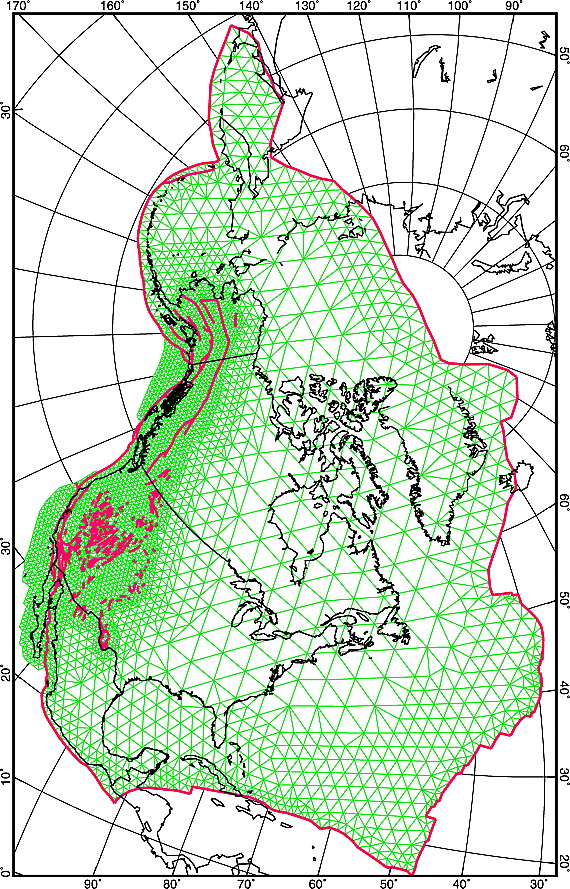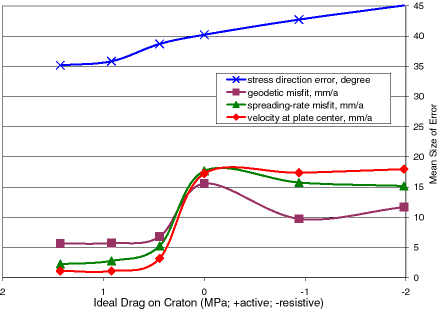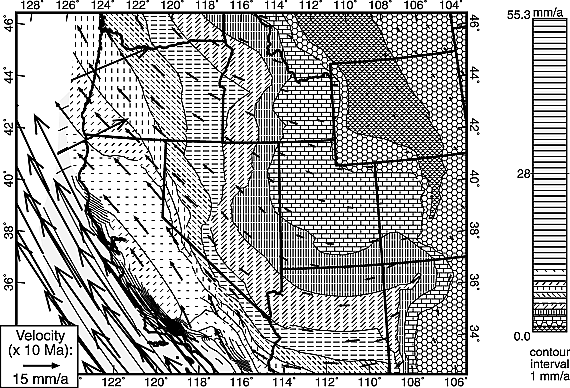
49. Liu, Z., and P. Bird (2002b) North America plate is driven westward by lower mantle flow, Geophys. Res. Lett., 29 (24), 2164, doi:10.1029/2002GL016002.
The sense of shear traction which the deeper mantle exerts on the North America plate is controversial. To test this, we compute laterally-varying thin-shell models. Fault elements are used to outline the plate, so the velocity of North America is not fixed. The basal boundary condition is set in one of three ways: (a) for resistive drag, we assume that the lower mantle is static with respect to Africa; (b) we test models with no basal traction; (c) for active drag, we assume that the lower mantle moves as a rigid plate but 10% faster than North America. Each model is scored by comparison with sea-floor spreading rates, geodetic velocities, stress directions, and NUVEL-1A. Only models with active drag are successful. While these results do not determine the exact azimuth or pattern of basal drag on the North America plate, they establish the modal sense as active (southwestward) mantle drag on the base of the cratonic part of the North American continent.
Acknowledgement: This material is based upon work supported by the National Science Foundation under Grant No. 9902735. Any opinions, findings and conclusions or recomendations expressed in this material are those of the author(s) and do not necessarily reflect the views of the National Science Foundation (NSF).
entire paper as a 4-page, 781 KB .pdf (2 color figures, 1 b/w figure; minor omission in Figure 3)
Postscript: In 2015, Kaban et al. [2015, nature geoscience, 8, 797-800] devised a creative test for the sense of mantle convection under North America, by using gravity and tomographic data to detect the deflection of the base of the cratonic root under south-central Canada. Its deflection of about 800 km to the southwest is in agreement with our model, at least in terms of the sense of simple shear under the North American craton.

Figure 1. Thin-shell finite element grid NAP2 used in these experiments. The model domain is the entire North America plate plus adjacent deforming regions of the Pacific plate. Heavy lines are fault elements; light lines are boundaries of continuum elements. Oblique Mercator projection.

Figure 2. Results of 6 models with fault friction 0.03, as a function of magnitude and sense of shear traction applied to base of the lithosphere (‘‘ideal drag’’ of Table 1). Active (westward) drag produces much smaller errors than zero or resistive drag. [Note: This version includes the full text of the key, some of which was missing in the .pdf version.]

Figure 3. Detail of velocity in the western United States from one relatively successful model with westward mantle drag. Velocity shown at 1/4 of nodes for clarity. Agreement with geodesy [Bennett et al., 1999] is good (6 mm/a RMS, after elastic corrections for fault locking).